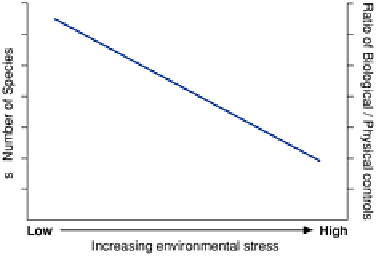Environmental Engineering Reference
In-Depth Information
Figure 23.5
The stability hypothesis to explain diversity. As
the number of community-biological relations in the
ecosystems increases, they act as a buffer against physical
controls, and the number of species increases.
more micro-variation in the physical environment than has been recognized so far.
Second, tropical forests have rapid turnover rates, with trees and branches falling all the
time and making gaps and clearings which can be colonized by equivalent but non-
competing species. This is a continuous process and gives rise to the large spatial
variability in what superficially may appear to be a uniform community. Figure 23.5
summarizes the Stability Hypothesis. As environmental stress increases, the diversity of
the community decreases. Also, communities become increasingly under the control of
the physical environment (climatic hazards, soil limitations, tides). Conversely,
communities in regions of little stress are controlled by essentially biological processes
(physiology and ecology).
In addition to differences in environmental stability, some ecologists have pointed out,
real regional differences in gene pools must exist, so that speciation rates in the tropics
are higher than in non-tropical latitudes. Thus in theory there would be a latitudinal
gradient even if extinction rates were uniform all over the globe. One way to achieve high
speciation rates in the tropics would be for the distribution of species to be more local,
fragmentary and patchy. Geographical barriers permit species to become spatially
isolated, to evolve in different directions (divergent evolution) and eventually to prevent
interbreeding. In this way tropical 'fringe' species can survive long enough to adapt to
local conditions and become a new species ultimately. In harsh environments (e.g. the
Arctic) 'fringe' species are totally eliminated. Speciation in this manner is called
allopatric speciation
and the 'Speciation Hypothesis' explains a mechanism enabling
THEORY OF ISLAND BIOGEOGRAPHY
systems
Islands have long held a fascination for biogeographers, since the famous studies of
Wallace and Darwin in the Pacific Ocean in the nineteenth century, right up to modern
studies by MacArthur and Wilson in the late twentieth century. Islands can be classed as
oceanic offshore or coral Another reason for interest has been the studies of colonization




